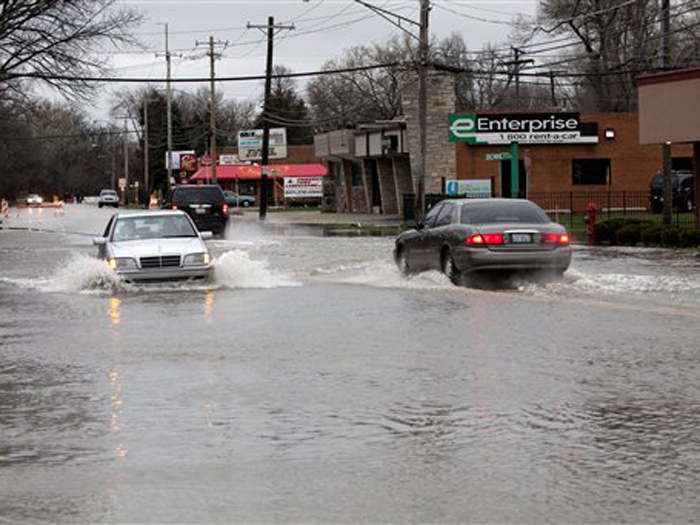So, How Insurable Is Flood Risk?

Nowhere is the insurance gap more pressing than in the case of flood insurance.
So says the Swiss Re Institute in its first Sigma report of 2022 on natural catastrophes. The Institute is the research arm of the Swiss insurance giant and has been issuing its Sigma analysis reports for more than 50 years.
For one thing, “Flood risk is complicated in that there is a significant human element to the risk that is unlike other perils,” said Matt Junge, head, property underwriting regional and national U.S.
Creeping Waters: Flood Risk and Its Reach
Flood affects more people around the world than any other peril. The Sigma report states that losses from flood have been on an upward trend globally and at a significantly faster pace than global GDP.
“Through 2011 to 2020, at near $80 billion, cumulative insured losses from flood events around the world were almost double that of the previous decade,” the report said. “The flood experience of 2021, with insured losses at $20 billion, indicates no let-up of the upward trend.
“Historically Asia has suffered the highest economic losses from flood, but it lags in terms of insured losses. There is a large flood protection gap across the world. Insurance has covered just 7% of the aggregate economic losses from flood events in emerging markets in the last 20 years, and 31% in advanced economies.”
Flood risk is complex to monitor, the Sigma reports: “Exposure accumulation with economic growth and urbanization has been the main driver of rising flood-related losses over time. However, many other factors such as aging or lack of flood control infrastructure, soil sealing in urban areas, more rainfall from tropical cyclones, and clustering of catastrophe events have also shaped loss outcomes.”
The report continued: “Changing climate also needs to be considered in present-day and for future risk assessment. For instance, in scenario analysis, we project for 2050 more pronounced increases in UK flood-related losses for high return periods, assuming no adaptation interventions.”
Greater granular understanding will improve the accuracy of flood risk costing and facilitate the development of innovative risk transfer solutions, the report said. “It can also help inform local mitigation planning and disaster risk management.”
What the Industry Is Poised to Do
Addressing the increasing effect of flooding has to be a cooperative effort amongst insurers, governments, builders and banks if it is to truly have a comprehensive approach, Swiss Re said.
“The single best step for the insurance industry to take is to create private flood insurance options that contribute to closing the flood protection gap,” Junge said.
“Far too often, insurers think of flooding and immediately think of repetitive loss properties located next to a body of water. There are millions of properties nationwide that have a flood risk that can be understood and priced by the insurance industry to provide much needed coverage.”
Junge continued: “Along with this comes an investment in education for property owners about the risks of flooding that the industry plays a large role in.”
The Sigma report also raises whether re/insurers should be taking the lead in what might amount to infrastructure development.
“Just like with other perils, insurers can encourage infrastructure improvements and give suggestions on buildings codes, but I think it is unrealistic for insurers to take the lead in the development,” Junge said. “Partnering with government, whether at a local, state or federal level however is something Swiss Re is already active in as we work on closing the flood protection gap.”
Climate Change and Other Drivers
Sigma found that only 25% of global economic losses from major flood events were insured in 2021, indicating a global protection gap for the most commonly occurring risk, one that affects more than a third of the global population.
Realizing the critical need for solutions in this area, the report said, the private insurance market is focused on making improvements in technology and modeling to help make flood risk insurable.
The report stated that global economic losses from natural catastrophe events in 2021 reached $270 billion, while insured losses totaled $111 billion, serving the insurance industry its fourth-costliest year since 1970. According to Sigma records, insured losses are increasing by an average of 5% to 7% annually worldwide, a sure sign, the report says, of how climate change is affecting our world.
Sigma also reported that climate change is anticipated to cause more frequent and more extreme weather events.
“Thus, future risk simulations need to be incorporated into risk assessments with a special focus on it and social-economic developments, such as growing populations, rapid urbanization and the accumulation of economic wealth in disaster-prone areas,” the report stated.
In other findings, Sigma reported that the major drivers of insured losses were secondary perils, including floods, wildfires and severe storms. While Hurricane Ida was the costliest natural disaster last year, flooding is by far the most frequently occurring natural peril, accounting for 31% of global economic losses from natural catastrophes in 2021,which is only 2% less than hurricanes.
The report added that “a recent study by S&P Global estimates that a $150 billion insured loss event has an empirical return period of 10 years. Considering the exposures of the top 21 global reinsurers, however, the study also estimates that on average, industry models see losses of such magnitude occurring only once in every 20 to 30 years.”
This suggests that the industry is not following empirical data.
“After a relatively quiet phase of global natural catastrophe activity for a number of years from 2012 to 2016, we have observed significant losses from a combination of primary and secondary perils in the last five years,” Junge said.
“While climate change impacts specific weather-related catastrophes [e.g. wildfires experienced in California in recent years], other factors such as urbanization and exposure growth in exposed areas are also significant contributors to expanding natural catastrophe risk, which needs to be considered by the industry.” &
The Sigma’s authors included Lucia Bevere, senior catastrophe data analyst, and Dr. Federica Remondi, flood lead, with contributions from Neil Aellen, Dr. Kishor Dhore, Dr. Gianluca Mussetti and Dr. Steve Tuozzolo.










